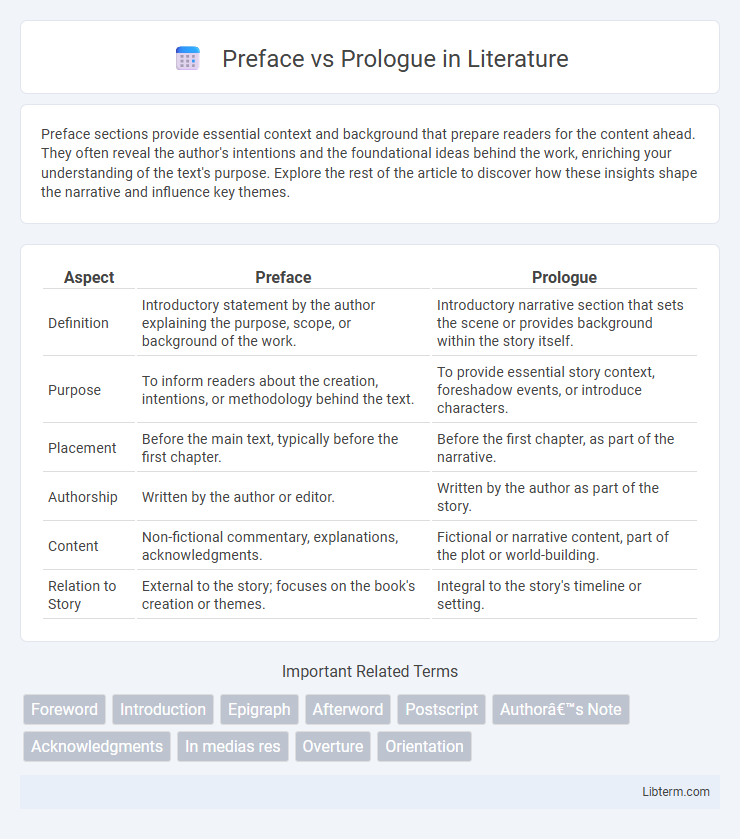Preface sections provide essential context and background that prepare readers for the content ahead. They often reveal the author's intentions and the foundational ideas behind the work, enriching your understanding of the text's purpose. Explore the rest of the article to discover how these insights shape the narrative and influence key themes.
Table of Comparison
| Aspect | Preface | Prologue |
|---|---|---|
| Definition | Introductory statement by the author explaining the purpose, scope, or background of the work. | Introductory narrative section that sets the scene or provides background within the story itself. |
| Purpose | To inform readers about the creation, intentions, or methodology behind the text. | To provide essential story context, foreshadow events, or introduce characters. |
| Placement | Before the main text, typically before the first chapter. | Before the first chapter, as part of the narrative. |
| Authorship | Written by the author or editor. | Written by the author as part of the story. |
| Content | Non-fictional commentary, explanations, acknowledgments. | Fictional or narrative content, part of the plot or world-building. |
| Relation to Story | External to the story; focuses on the book's creation or themes. | Integral to the story's timeline or setting. |
Introduction to Preface and Prologue
A preface introduces the book by explaining the author's purpose, background, or circumstances surrounding its creation, often written by the author. A prologue serves as an opening to the story, providing important background information or setting the scene to enhance reader understanding. Both elements prepare readers but differ in content focus: the preface is more about the book's creation, while the prologue advances the narrative.
Defining a Preface
A preface is an introductory section written by the author explaining the origin, purpose, and scope of the book, often including acknowledgments or the writing process. Unlike a prologue, which is part of the narrative and sets the story's scene or background, a preface addresses the reader directly about the book's creation or context. Prefaces help establish authorial intent and provide insight into the development of the work without advancing the plot.
Understanding the Prologue
A prologue serves as an integral narrative element that introduces key themes, background information, or events preceding the main story, often from a unique perspective or timeframe. Unlike a preface, which typically provides the author's intent or context, a prologue immerses readers directly into the fictional universe, setting tone and mood while foreshadowing plot developments. Understanding the prologue enhances comprehension of character motivations and story arcs, enriching the overall reading experience.
Key Differences Between Preface and Prologue
A preface is an author's introduction explaining the inspiration, research, or purpose behind the book, often written by the author and placed before the main text. A prologue is a narrative section that provides background information or sets the stage for the story, written from the perspective of a character or omniscient narrator. The key differences lie in their function: the preface is meta-textual and non-fictional, while the prologue is part of the fictional narrative structure.
Purpose of a Preface in Books
A preface in books serves to introduce the author's intent, provide context about the writing process, and explain why the work was created. It often addresses the audience directly and can include acknowledgments or insights into the development of the book's content. Unlike a prologue, which is part of the narrative, the preface is a separate section that enhances reader understanding before diving into the main text.
Role of a Prologue in Storytelling
A prologue serves as a narrative device that sets the stage for the main story by providing essential background information, context, or a glimpse into events occurring before the primary plot. It enhances storytelling by building suspense, introducing key themes, or revealing character motivations that influence the narrative's progression. Unlike a preface, which typically addresses the reader or explains the author's intent, a prologue is an integral part of the story's fictional world and timeline.
Common Features of a Preface
A preface is an introductory section of a book where the author explains the purpose, scope, and background of the work, often including acknowledgments or the inspiration behind the writing. Common features of a preface include the author's voice discussing the writing process, the intended audience, and any significant changes from previous editions. Unlike a prologue, which serves as a narrative introduction to the story, a preface provides factual context and personal insights about the book itself.
Typical Elements of a Prologue
A prologue typically includes elements such as background information, setting the scene, or introducing key characters and events that are crucial for understanding the main story. It often provides context or foreshadowing, establishing the mood and tone before the narrative begins. Unlike a preface, which focuses on the author's intent or acknowledgments, a prologue is an integral part of the story world and narrative structure.
When to Use a Preface or Prologue
A preface is used when the author wants to explain the origin, purpose, or context of the book, often reflecting on the writing process or acknowledging contributors. A prologue is employed to provide background story or set the scene for the narrative, enhancing the reader's understanding of the plot before the main chapters begin. Choosing a preface or prologue depends on whether the emphasis is on authorial insights or narrative context.
Conclusion: Choosing the Right Opening
Selecting between a preface and a prologue depends on the purpose and content of the book's introduction. A preface typically offers the author's background, intent, or acknowledgments, while a prologue provides a narrative setup or context for the story. Understanding their distinct roles ensures the right opening enhances reader engagement and clarifies the book's framework.
Preface Infographic

 libterm.com
libterm.com